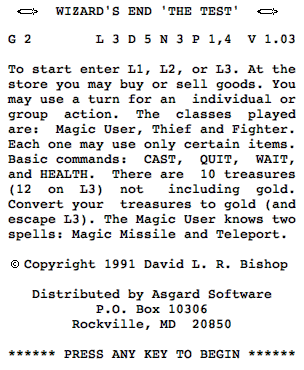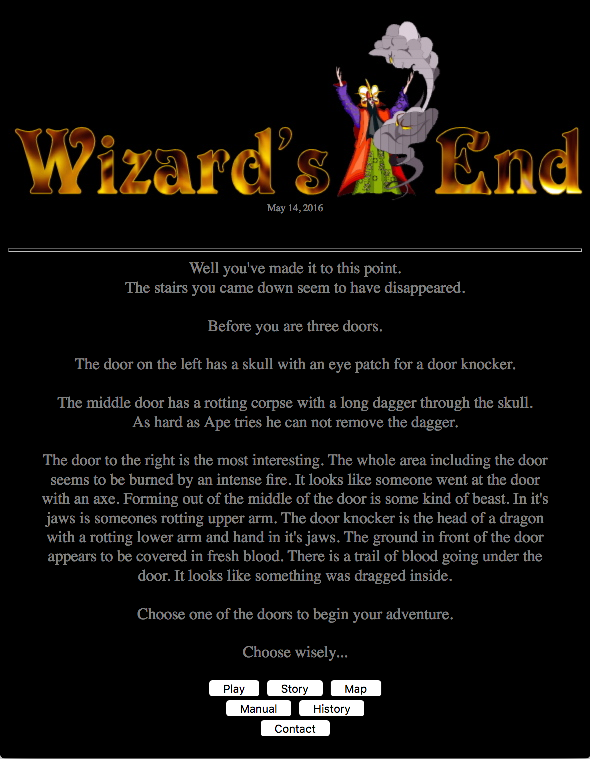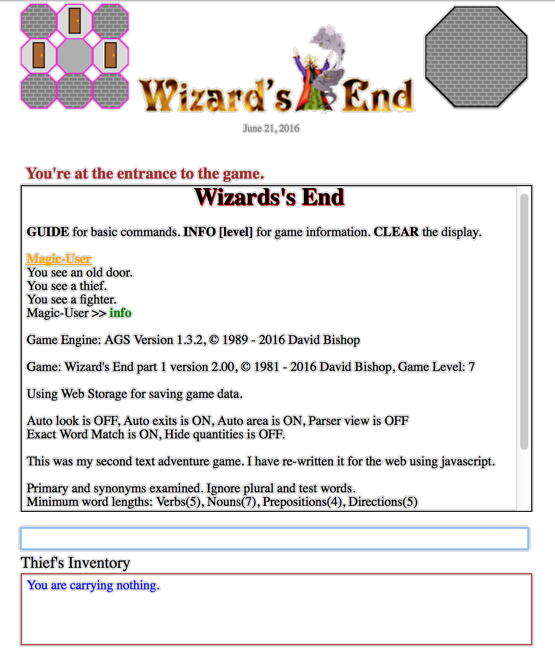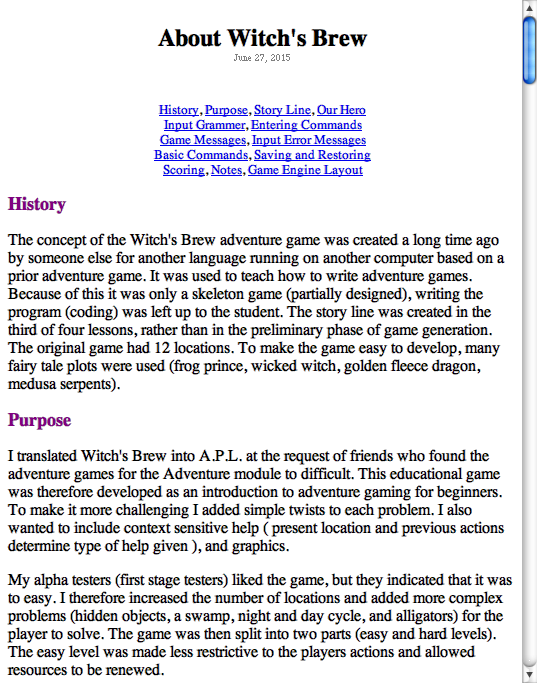In memory of my mother and father
Mary Virginia Bishop, Feburary 9, 1931 - March 22, 2000
Lurton La Rue Bishop, December 28, 1924 - November 26, 2003
Home Accounting automates the management and budgeting of your personal cash registers ( checking, saving, etc. )
Home Accounting a1 Article
Home Accounting a4 Article
Home Accounting a4 Screenshots
Home Video Library helps you manage your video tape library.
This version introduces the dynamic data base extensions, export/import features, multiple column sorting/searching and display filtering.
Note: This program was created to develop Home Accounting's data base engine.
Concentration ][ helps you improve your memory in a fun way. It was written to replace an older version by the name Concentration that worked only under system 6.
Convert AVHRR converts an avhrr .r file into raw graphic files.
Bishop's Draw was written to show other CPX programmers how to write a drawing program and how to extend the ABC graphic classes. It also shows how to do tear-off palettes, color management etc.
NOTE:
This program was created to develop Home Accounting's pen manager ( color management system, was the palette manager ).
The Adventure Gaming System ( AGS ) allows one to create a role playing game for multiple players. It is based on games played with the role playing game system, Advanced Dungeons and Dragons by TRS.
With it you develop your world, the objects it contains, the rules things operate by and any special objects that you want. It is designed to create game modules that handle an unlimited number of objects, locations and rules.
The system comes with thousands of pre-generated objects, graphics, basic maps and hundreds of characters. The package also includes two of my own game modules as examples; Witch's Brew ( level 1 ) and Wizard's End part 1 ( level 7 ).
Also provided is the AGS Player application. The AGS Player is freeware and there are no restrictions on it's distribution. There are no fee's associated with the game modules you create. You can give them away or charge for them at your discretion. The player application does have security features that prevents the playing of unauthorized commercial game modules.
In Wizard's End there are three characters; a Thief, a Fighter and a Magic-User. The Thief and Fighter find a map to what they believe shows the way to vast treasures. However, the map indicates the presence of magic so they enlist the services of a friend of theirs who is an apprentice Magic-User. This game employs multiple solutions to every problem. There are three levels of difficulty. The first and second level are present to help players learn game play. Only completion of the third level of difficulty can the characters move on to part 2. The game consists of four parts. Each part is one skill level above the previous part. If the characters are successful, then the player will learn an important fact about, The Seven Seas of Carnon, the world of my games.
Introduction to Wizard's End
Introduction to The Seven Seas of Carnon
The following is the original opening screen shot from the Adventure Module version of the game.
Original opening screen.

New opening screen.

New game screen.

The following is the original opening screen shot from the Adventure Module version of the game, followed by several screen shots of the new javascript version.
Original opening screen.

New opening screen.

New (hard) game screen.

New about screen.

Quest for Wisdom was one of my earliest adventure games written in basic. It has been expanded and enhanced many times over the last few decades.
A young man stumbles onto an unexplored cave near his village. Upon entering he discovers that he can not get out the way he came in. As he explores further, he's given a challenge of two paths to follow, and thus begins his adventure.
Word Sort was written for a friend of mine to allow him to create dictionaries of words used in text documents.
I introduced computers into my class room back in the early 80's. I used the computer to create follow-up questions to my lessons. The program presented a question with multiple answers to the student. Since the students were from 4 to 6 years, I read the question and allowed the student to pick the answer. Of course they wanted to press the key. However, they had a lot of difficulty matching the letter on the screen with the letter on the keyboard. So I wrote Speed Key.
A large letter ( A to Z ) appears on the right side of the screen and moves slowly to the left until it hits a wall or the student presses the key of the same letter. If the key is pressed in time another letter appears and moves a little faster. The game allows a teacher to select what keys are used and the size of the character. The slowest speed is 1 and the highest speed is 128. I have achieve speeds of around 90 with practice. The students achieve speeds between 1 and 10. Also on computers that supported speech, the letter is spoken when the correct key is pressed.
I demonstrated this game to several friends and found it difficult to get them off the computer. My software distributor saw the game and asked me to convert it to cartridge form. It took me about a month to learn how to rewrite the assembly language games; Speed Key, Letter World and Giving, and compress them down so they all fit into a single cartridge.
Letter World was a follow-up game to Speed Key. It was written to overcome another problem. It helps my students recognize the same characters on the screen rather than what's on the screen with what's on the keyboard's keys.
In Letter World, letters are lost in space. The student is given a rocket ship with a net that they fly about the screen. The net takes to the shape of the letter to be recovered. When the net covers the letter to recover, they score. A counter indicates how many letters have been recovered. There are many levels of play possible. The player selects what letters are displayed, their size, speed and direction of travel. Because of the number of students, there is a timer that limits play time.
I also demonstrated this to my friends and once again they liked playing it with all the settings maxed out ( you need a quick eye for that kind of play ). With lots of practice a count of 20 to 30 was average at the settings for maximum difficulty.
Giving was written because of a lack of two player cooperative games for children.
In Giving, a flood has wiped out the food supply in the land of zingers. Two players work together to achieve the goal of feeding as many starving zingers as possible. The two players control two zingers named Beep and Boop ( named by my students because of the sounds they make ). The game is divided into two screens. The students are given 60 seconds on each screen. On the first screen they need to work together to plant some seeds and then water the seeds. They are given a pile of seeds, water bucket, basket, puddle and a pre-dug hole. If they get the seeds planted and watered in 60 seconds, then a plant will grow. The plant produces giant strawberry like food. This is the transition event too screen two. On screen two other zingers appear. The players job now is to pick the strawberries and give as many away as possible in 60 seconds. The rate of rejection and the speed of movement is adjustable. A counter is used to keep track of the number of zingers helped.
My first successful commercial product.
WaterWorks is an inverse maze solving games. From 1 to 10 players can play. Each player's game is independent of the other players and can be saved and restored at the beginning of each floor.
You have been contracted to install the plumbing for a 99 story building plus one basement. Your contract requires that you connect the inlet pipe to the outlet pipe. Your required to connect pipe to all taps on a floor. You may chose to use copper or lead plated pipe. The copper pipe is ten times more expensive than the lead pipe, but the lead pipe is subject to rusting, if the plating fails. Of course the building is located on the bad side of town. Between vandals, nature, your competitor, threats to the owner and strange happenings, you have your work cut out for you.
You are given $100 to buy pipe per floor. Each connection to a tap will provide additional cash during construction. Any left over cash is added to your credit. With credit you can buy additional items at the hardware store to help you over come the many obstacles you will encounter. Once you think you have completed a floor you ask for a city inspector to inspect your work. If you pass the inspection you proceed to the next floor. If you do not pass inspection, you must correct the faults. Each re-inspection will cost you more than the previous inspection. When you can not afford to pay an inspector the game ends for that player. There are several ways the game can end.
It is possible to descend to floors previously completed, forcing you to start again from the lower floor. On several floors can be found doors and other exit points that may lead to miniature games which must be completed in order to return to the floor or they may provide bonuses, free time or any number of other things. Not all objects encountered are bad, some add dollars when found, others add credit when found or can generate rewards when you pass inspection ( so don't let them be destroyed ).
Last updated: July 7, 2015